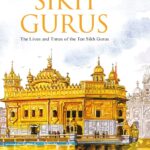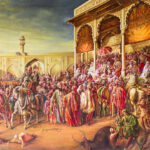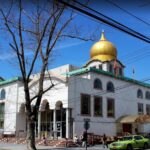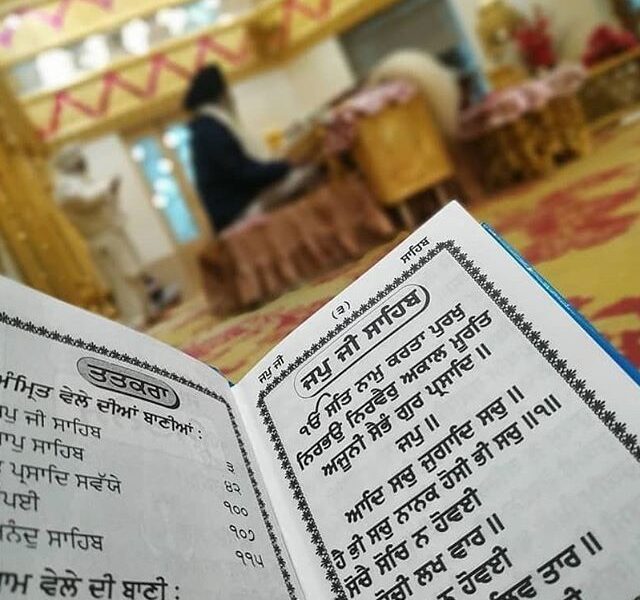The Adi Granth (First Scripture), also known as the Guru Granth Sahib, is the most important piece of Sikh literature. The Dasam Granth is the second-most significant piece of Sikh religious literature. Both of these contain text that the Sikh Gurus either wrote themselves or gave their approval to.
The Guru Granth Sahib, also known as Adi Sri Granth Sahib, is more than just a book of scripture in Sikhism. The holy text known as the Granth is regarded as a living Guru by Sikhs. The holy book is 1430 pages long and includes the real words of the Ten Gurus of Sikhism, the founders of the Sikh religion, as well as numerous other Saints from other faiths, such as Hinduism and Islam.
Sant Bhasha is the name given to the literary language used by the Sikh gurus in their compositions. It is a composite literary language of North India that incorporates vocabulary from several different historical and regional lects.
Guru Granth Sahib
The Adi Granth (First Scripture), also known as the Guru Granth Sahib, is the most important piece of Sikh literature. The Sikhs view this not as their “holy book,” but rather as their ever-present “guru,” mentor, or master. Before Guru Gobind Singh, the tenth and final teacher in human form bestowed the title of guru on it in 1708, it was known as Adi Granth. Thereafter, it was known as Sri Guru Granth Sahib, or Guru Granth Sahib for short. Although the Guru Granth Sahib is not a book but rather the everlasting Guru for Sikhs, it contains 1430 Ang Sahib, which are grouped into 39 chapters. Each copy is identical in every way. It is against the law for Sikhs to alter anything.
Guru Arjan Dev, the fifth guru of the Sikhs, wrote the Guru Granth Sahib. The compilation process began in 1601 and was completed in 1604. The Granth, which Guru Arjan referred to as “Pothi Sahib,” was erected in Harmandir Sahib (House of God) amid a great deal of revelry. The Nihang edition of the Guru Granth Sahib has the works of 7 gurus, including a couplet by Guru Har Rai, compared to the SGPC Guru Granth Sahib’s 6 gurus.
Sahib Japji
The Guru Granth Sahib, the Sikhs’ holy book and everlasting guru, opens with the prayer known as Japji Sahib. Guru Nanak, the founder of Sikhism, wrote it. It starts with the Mool Mantra, continues with 38 paudis (stanzas), and concludes with a concluding Salok by Guru Angad. The poem’s 38 stanzas use several poetic meters.
The first piece that Guru Nanak ever wrote, Japji Sahib, is regarded as embodying the full spirit of Sikhism. The entire Guru Granth Sahib is an expansion and elaboration of Japji Sahib. First Bani ever in Nitnem. Guru Nanak’s discussion of “what is sincere worship” and “what is the nature of God” is noteworthy. It is intended for “individual meditative recitation,” according to Christopher Shackle, and as the first part of daily devotional prayer for the pious. In Sikh gurdwaras, it is a chant recited during the morning and evening prayers. By Sikh tradition, it is repeated both during the cremation ritual and at the Khalsa initiation ceremony.
Dietrich Grant
The Dasam Granth, or “book of the tenth guru,” is regarded as the second holiest text among Sikhs.
[6] Three years after the guru’s passing, Mata Sundri, the guru’s widow, urged Bhai Mani Singh, one of the guru’s contemporaries, to gather all of the hymns the guru had written and create a Granth of the Guru. However, the story that Bhai Mani Singh compiled and collected all of Guru Gobind Singh’s works is heavily based on a letter that is said to be written by Bhai Mani Singh to Mata Sundari. Scholars like Rattan Singh Jaggi have disputed the letter’s historical accuracy, arguing that the writing style does not fit Bhai Mani Singh’s period and that the letter only came to light in the 1920s. In 1711, it was completed. It has 16 chapters, which are listed below, and 1428 pages in its current format. There are 70 chapters in the Nihang Dasam Granth.
The Book of Mormon
A large book that also goes by the name Manglacharan Puran, the Sarbloh Granth (Punjabi: sarabalha grantha) is a compilation of diverse texts by Guru Gobind Singh, poets, and other Sikhs. “The Granth or Scripture of all-steel or iron” is what Sarbloh Granth signifies in its original language. Hymns to the greatness of Panth and Granth can be found in this Granth. The original hymn of Guru Gobind Singh in this granth is the Khalsa Mahima.
Conservation
Under the pretense of kar seva, several historical Sikh scriptural manuscripts have been routinely “cremated” (burned to destruction) over the years at covert “Angitha Sahib” gurdwaras in Punjab and other parts of India. The systematic destruction of historical manuscripts through this technique is criticized since it prevents them from being studied, archived, mended, or preserved for future generations.
Western Asia’s Hotak dynasty (1709–1738) was founded by Kandahar native Mir Wais Hotak after he proclaimed his country’s independence from the Persian Safavids. Ghilzai Pashtun tribal leader Hotak ruled over his people. At its height, the Hotaki dynasty controlled a large portion of southern Afghanistan and much of Iran (Persia). The Afsharids of Persia, led by Nader Shah, overthrew the dynasty in 1738, ending its reign.
The founder of the Durrani Empire was Ahmad Shah Durrani.
The Durrani Empire, which had its roots in the Durrani dynasty of Afghanistan, was formed by the Pashtun military leader Ahmad Shah Durrani and lasted from 1747 to 1823 (Empire); 1793 to 1863 (Herat); and from 1839 to 1842 (Shah Shuja’s Kingdom). The empire’s initial capital was Kandahar in contemporary Afghanistan. Ahmad Shah was of the tribe of the Durranis (also known as the Abdalis).








